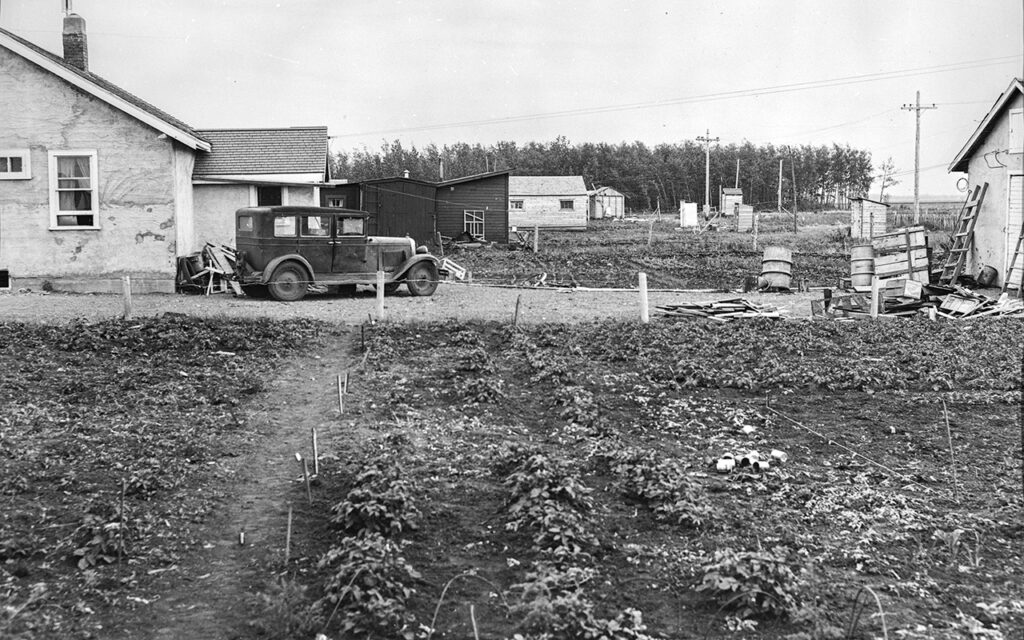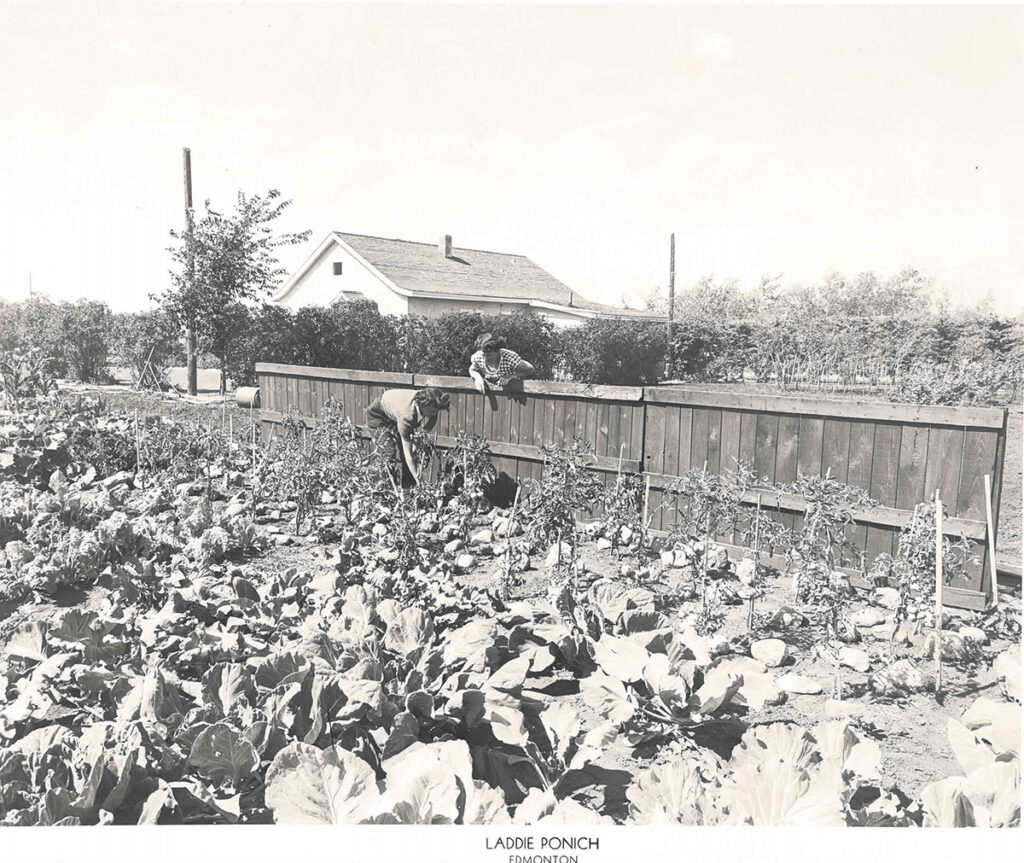Gardens and farms: growing, harvesting, and foraging.

Paula E. Kirman
Food security is an issue that people all over Edmonton deal with, both today and in the past. When it comes to Jasper Place, residents had various ways to grow and acquire food. This first in a series of articles concerning food security in Jasper Place addresses gardens, how the bounty was preserved, and foraging for readily-available produce like mushrooms and berries a little ways out of the area.
A number of residents had family gardens used as a source of fresh fruits and vegetables. Kelly* recalls: “We had a huge garden behind our house on 159 Street. Lots of fresh vegetables and chickens from my grandmother’s farm.”
Says Colleen: “Of course we had a huge garden – most of our back yard was filled with potatoes (my Dad’s favourite), green onions, Swiss chard, beets (and their beet greens), radishes, green beans, peas – and weeds, lots of weeds! I hated weeding which never ended and included getting rid of wild horseradish (the worst).”
Vic remembers that “every second front yard had potatoes in Mayfield.” Vicki lived on 149 Street and 81 Avenue, and in the 1960s her family “had a large garden with all kinds of vegetables. Lots of raspberries and rhubarb.”
Joan’s family “always had a veggie garden [with] potatoes on one side of the yard. Carrots, peas, beans, tomatoes and onions on the other side. There was a hedge of raspberry plants and lots of rhubarb.”
In addition to enjoying fresh vegetables from the garden, some families preserved their harvest through canning. Says Jo, “We grew a big garden and canned most of it. We also had many family members on the farm for meat.”
Farms were common back in the day, as was poverty and subsistence living, which would account for why gardening was so prevalent. As mentioned in the Jasper Place Historic Resources Inventory, “Self-sustenance remained an integral defining feature of the community with residents constructing small houses on large lots to allow for generous gardens, space for an outhouse, and area to burn garbage.”1
Ken (Bud) Newman discusses his family’s farm in an interview with JPCHP. “We ended up on a farm with two cows, Betsy and Mary; they were milk cows; about a dozen or so chickens, with a very mean rooster that used to chase me as a little kid; a dog, Goldie, a nice cocker spaniel which had a litter of puppies during one period there,” he recalls.
The Newman farm was largely a supplement to the family’s food security, which provided milk. The family also had a vegetable garden, which “always had lots of carrots and peas. Grew up loving vegetables, carrots and peas particularly. And some mint around one of the corners of the house brings back a memory there.”

Carl was part of a large family that “grew all our vegetables [and] bought most of our meat from local stores and butchers. Some we hunted ourselves. We grew our own crabapples, strawberries, and raspberries to can to make our own jams and jellies.”
These gardening successes were in spite of poor soil conditions. In an interview with the Jasper Place Community History Project (JPCHP), resident Chrystia Chomiak recalls the soil “had a lot of clay. So they brought in, and every year they would bring in, tons of horse manure. A truckload would come up, dump it, and my father would cart it out and they would break it up. So they really enriched the soil.”
As a result, her mother’s garden flourished. “The cucumbers were magnificent, the cabbage, the tomatoes – tons. She would can the tomatoes; she made her own ketchup. We were kids and we wanted to have French fries and ketchup. Beets, radishes, everything for borscht.”
Jean Côté also recalls poor soil conditions and the prevalent gardens in both front and back yards. “The topsoil was always infested with quack grass. For about two years you’d grow potatoes, especially in the front yard – it’s easy to weed them. It’s work, but it can be done, and you gradually get rid of all the quack grass and the quack grass roots. Then after that, maybe if you have time, you put in a front lawn,” he says in an interview with JPCHP.
“But meanwhile, of course, the back yard you dig all up and have a vegetable garden,” he continues. “Back in those days almost every house had a vegetable garden in the back, whether the people had lots of money or no money. If you walked down back alleys in Edmonton, both sides of the alley were vegetable gardens. Not so anymore, but back then, yes.”
Maxine Hebert is a writer who grew up in Jasper Place. She has written extensively about a lot about food preparation in her articles, which readers can find here.
Apache Seeds, located at 10136 149 Street, has been the area’s garden centre since 1958, selling everything from seeds to gardening supplies to housewares and gifts. You can learn more about Apache Seeds in an article available here.2
In order to improve soil quality, Barrie Touchings’ father got peat moss from the area that is now the Meadowlark Health and Shopping Centre. “That area was full of peat moss, they were digging that peat moss out. My dad borrowed a single axle large dump truck from his older brother, and I remember he probably got 25 loads of this peat moss that they were digging out and brought it to our house and spread it in the back yard so we could continue to have a garden,” he says in an interview with the JPCHP.
Chomiak’s mother also enjoyed going on adventures outside of Jasper Place in the woods to pick mushrooms. “The goal was to hitch a ride with somebody and promise them that they’d take them to a place where there were good mushrooms, and off they would go and collect a variety of mushrooms.”
Barrie Touchings and his parents would head to Clyde, north of the area near Westlock, to pick blueberries. “We’d go blueberry picking every fall, we’d come home with three or four washtubs full of blueberries. [My mother] would freeze those, can them in the early days and then freeze after we got a freezer. My dad every fall would get a hundred pounds of sugar and a hundred pounds of flour, and that was to last us for the year,” says Touchings.
In general, gardening in Jasper Place tended to be fruitful. Sarah lived on 150 Street and 87 Avenue. “We had a huge lot and the garden was enormous – every vegetable imaginable, including gooseberries, red currents, dark currents, raspberries, [and a] crabapple tree,” she recalls.
“We stored huge tubs of carrots in sand all winter in the garage,” Sarah continues. “Mom canned beets, green beans, carrots, and fruit sent to us by train from relatives from Mission, B.C. [which] included sacks of plums, corn, walnuts, and sockeye salmon in ice – which she also canned. We picked fresh vegetables to eat [in] July [and] August, and owned a few acres which are now is part of Edmonton Country Club. We planted more potatoes there.”
In part two of our series, we will look at food delivery services in Jasper Place.
Notes
*Quotes are from responses to questions posted on social media. Only first names are being used. Responses have been edited for length and clarity.
1Donald Luxton and Associates Inc. and The City of Edmonton, Jasper Place Historic Resources Inventory, City of Edmonton: February 2019, p 20.
2Donald Luxton and Associates Inc. and The City of Edmonton, “Apache Seeds,” in Jasper Place Historic Resources Inventory, City of Edmonton: February 2019, pp. 74-75 (PDF available here. Courtesy of the City of Edmonton).
Paula E. Kirman is a freelance writer who grew up, and still lives, near the Jasper Place area.
[This post is an expanded version of an article that appeared in Spring 2024’s SPANN]
Do you have any comments about this article or memories to share? Click here.


